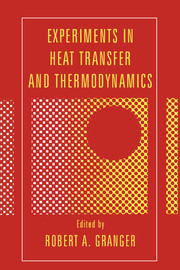Book contents
- Frontmatter
- Contents
- Preface
- Introduction
- Part I Experiments in heat transfer
- I.1 Conduction
- Experiment 1 Critical radius of insulation
- Experiment 2 The regelation of ice – the effect of heat conduction
- Experiment 3 Unsteady heat conduction in a sphere
- Experiment 4 Heat conduction in materials with nonhomogeneous structure
- Experiment 5 Measurement of thermal conductivity of solids during chemical reactions
- Experiment 6 Temperature measurements in a transparent material: Application of the holographic interferometry
- I.2 Convection
- I.3 Boiling
- I.4 Mixing, dispersion, and diffusion
- I.5 Radiation
- I.6 Heat pipes and exchangers
- Part II Experiments in thermodynamics
- Appendix 1 Experiments and demonstrations in thermodynamics
- Appendix 2 Experiments and demonstrations in heat transfer
- Appendix 3 Heat-transfer and thermodynamic films
- Index
Experiment 5 - Measurement of thermal conductivity of solids during chemical reactions
Published online by Cambridge University Press: 05 June 2012
- Frontmatter
- Contents
- Preface
- Introduction
- Part I Experiments in heat transfer
- I.1 Conduction
- Experiment 1 Critical radius of insulation
- Experiment 2 The regelation of ice – the effect of heat conduction
- Experiment 3 Unsteady heat conduction in a sphere
- Experiment 4 Heat conduction in materials with nonhomogeneous structure
- Experiment 5 Measurement of thermal conductivity of solids during chemical reactions
- Experiment 6 Temperature measurements in a transparent material: Application of the holographic interferometry
- I.2 Convection
- I.3 Boiling
- I.4 Mixing, dispersion, and diffusion
- I.5 Radiation
- I.6 Heat pipes and exchangers
- Part II Experiments in thermodynamics
- Appendix 1 Experiments and demonstrations in thermodynamics
- Appendix 2 Experiments and demonstrations in heat transfer
- Appendix 3 Heat-transfer and thermodynamic films
- Index
Summary
Objective
Thermal conductivity is one of the most important thermophysical properties in the evaluation of heat flow rate within a solid. Various methods such as the absolute method, the twin plate method, the hot-wire method, and so forth, so far have been proposed for the thermal conductivity measurement of solids. These conventional methods, however, are not applicable for measurements of thermal conductivity when the materials to be measured are subject to phase change or chemical reaction. It is difficult in these methods to eliminate the additional heat flow released by phase change or reaction from the total heat flow.
A novel method for measuring thermal conductivity of solids in such an unsteady-state accompanied by heat-generation or heat-absorption is described. In this method, the value of the effective thermal conductivity in the process of reaction is evaluated from the integrated time change of the temperature of the reacting solid material (D.T.A. curve), by removing the effect of the reaction heat.
Background
The principle equation for determining the thermal conductivity in the process of reaction can be derived by referring to a D.T.A. (differential thermal analysis) measurement (see Table 5.1).
- Type
- Chapter
- Information
- Experiments in Heat Transfer and Thermodynamics , pp. 23 - 32Publisher: Cambridge University PressPrint publication year: 1994



